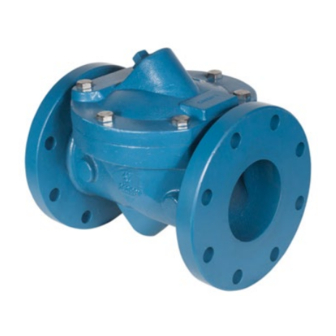DeZurik APCO 100SR Installation, Operation And Maintenance Manual - Page 4
Browse online or download pdf Installation, Operation And Maintenance Manual for Control Unit DeZurik APCO 100SR. DeZurik APCO 100SR 14 pages. Rubber flapper swing check valves

DeZURIK
APCO CRF Rubber Flapper Swing Check Valves
Description
A rubber flapper swing check valve consists of a valve body, a cover, and a flapper that is connected to
the body and cover. The flapper swings away from the valve seat to allow flow in the forward direction,
and returns to the valve seat when upstream flow is stopped to prevent backflow. They can be
equipped with optional adjustable spring assist, spring return or bottom mounted buffer attachments.
Handling and Storage
Lifting the valve improperly may damage it. Do not fasten lifting devices to the actuator or through the
seat opening in the body. Lift the valve with slings, chains or cables fastened around the valve body, or
fastened to bolts or rods through bolt holes in the flanges.
If installation will be delayed, place valve indoors in secure, weather tight storage. If temporary outside
storage is unavoidable, make sure a vermin proof rain cover (water shedding tarp, etc.) is secured
around/over the equipment to keep off rain and mud. Skid and set the assembly on a flat, solid, and
well drained surface for protection from ground moisture, runoff and pooled rain water.
Installation
The APCO CRF Rubber Flapper Swing Check Valve may be installed in either horizontal or vertical
position (with the flow upward). The embossed flow arrow on the valve body must be pointing in the
direction of flow. Valves with Bottom Mounted Buffer, the oil tanks (27) and (32) of Figure 2 must
always be in upright position. Unless otherwise specified, the valves are shipped for horizontal
installation.
1. Before installation, remove foreign material such as weld spatter, oil, grease, and dirt from the
pipeline.
2. Prepare pipe ends and install valves in accordance with the pipe manufacture's instructions for
the joint used.
Do not deflect the pipe-valve joint. Minimize bending stresses in the valve end
connection with pipe loading.
If excessive seat leakage occurs during start-up, recheck the installation and
eliminate any distortion to the valve body.
•
Ensure the valve and pipeline flanges are concentric to ensure proper flange sealing and seat
leakage control.
•
Tighten the flange bolts or studs in a crisscross pattern and minimum of four stages.
Fusion/Powder Coated Valves
Valves with fusion/powder coated exterior paint require flat washers to be installed
under the flange nuts when installing the valve to the pipeline flange to prevent the
paint from cracking or chipping.
D12007
Page 4
December 2012
